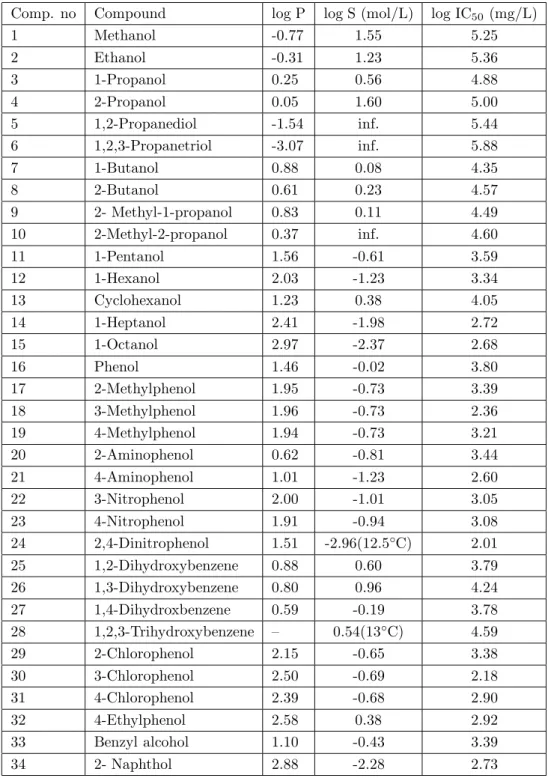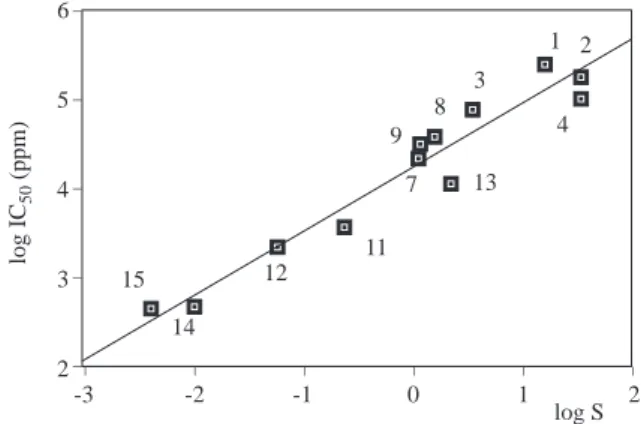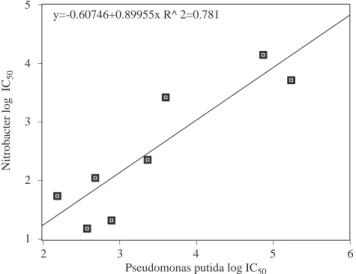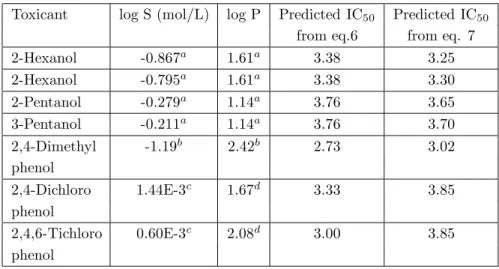c
T ¨UB˙ITAK
Determination of Structure-Toxicity Relationship of
Amphiprotic Compounds by Means of the Inhibition
of the Dehydrogenase Activity of Pseudomonas putida
S¸ermin G ¨UL, Dilek ¨OZT ¨URKC¸ ukurova University, Faculty of Sciences and Letters Department of Chemistry, 01330 Adana-TURKEY
Received 22.11.1995
Aliphatic and aromatic alcohols are amphiprotic compounds which have both polar and nonpolar parts in their structure. These compounds were studied with respect to the nonreactive toxic effects on the microorganism Pseudomonas putida. The toxicity of these chemicals to aerobic bacterium P. putida was measured in terms of inhibition of dehydrogenase activity. The test results, expressed as concentration of chemicals 50% effective in inhibition (IC50), were correlated with their physicochemical
properties such as aqueous solubility (S) and octanol-water partition coefficient (P).
Introduction
Water pollution has become a major global environmental problem. Surface waters are heavily polluted with organic compounds persistent to biodegradation at an increasing rate every year. Most of the organic compounds can be degraded under aerobic conditions by different bacteria but some of them are persistent to aerobic degradation1. Therefore, toxicity tests of chemicals using bacterial play an important role in
their effects on the aquatic ecosystem. Since the bacteria have the shortest response time among the aquatic organisms to changes in their environment, they could be sensitive indicators of the hydrophobicity of organic compounds15,16. In this respect, it has been used to predict the extent of bioaccumulation of organic
pollutants in biological systems. Hansch et al14first proposed a linear relationship between aqueous solubility
and the octanol-water coefficient. Later, Chiou et al17 developed this relationship more quantitatively for environmental chemicals and subsequent correlations have been proposed by many researchers18−27.
The objectives of the present study were to assess alcohol toxicity to bacteria since this group is an important component of the ecosystem, to use the bacteria as early indicators of environmental problems and to establish structure-activity relationships.
Experimental
Dehydrogenases are involved in vital anabolic and catabolic reactions and seem ideal for use in such toqicity studies28. In this toxicity method, resazurin acts as an electron acceptor29. Aliphatic and aromatic
alcohols act as nonspesific toxicants which have inhibitory effects on bacterial cells corresponding to chemical concentration. Toxicity measurements are based on the quantitative reduction of resazurin to resorufin by microbial dehydrogenase and is measured spectrophotometrically. Chemical reducing substances (aliphatic and aromatic alcohols) in water inhibit microbial dehydrogenase. This inhibition causes decreased reduction of resazurin which is related with the toxicity of these chemicals. The reduction of resazurin to resorufin by microbial dehydrogenase is shown in Figure 1.
O O N O O O O O N Dehydrogenases
Figure 1. The reduction of resazurin to resorufin by dehydrogenase of P. putida.
Materials
Aliphatic alcohols with C1C8 carbon chains, aromatic alcohols including substituted phenols, benzyl alcohol
and 2-naphthol were used (Table 1). All compounds were purchased from E. Merck and Sigma Chem. Co and they were analytic reagent grade.
Test organism
P. putida is a soil and water organism isolated from putrid materials. P. putida strains will grow at 37◦C. It is aerobic and facultative28.
The lyophilized DSM-50026 strain of P. putida was purchased from the German Collection of Microor-ganisms and Cell Cultures (DSM-GmbH, Braunschweig, Germany). The bacteria were grown on Standard 1 nutrient agar28,29 (for approximately 18h) at 26◦C. Prior to the experiments, the culture was transferred to
a flask containing fresh Standard 1 nutrient broth (E. Merck). After overnight growth (16±2h) on a shaker at 21◦C, 0.1 mL of the culture was transferred to another flask containing fresh medium. This transferring process was repeated until an active culture was established18. The cell concentration was adjusted to
0.55±0.05 O.D436 nm.
Determination of toxicities
The experiments were carried out in standard 2x15 cm test tubes at 37◦C in a water bath, adding 0.5 mL of culture to the tubes containg samples and reagent control which were prepared by the following method.
A: Reagent control : 5 mL distilled water+0.5 mL imidazol buffer + 1 mL resazurin solution B: Blank sample : 5.5 mL borate buffer +1 mL resazuring solution
C: Sample : mL solution of alcohol +0.5 mL imidazol buffer +1 mL resazurin solution. Resazurin solution was prepared at 75 ppm concentration. The pH of the buffer solution of imidazol (0.1 M) was adjusted to 6.3 with 1.0 M hydrochloric acid. The pH of the borat buffer solution (0.1 M) was adjusted to 11.0 with 1.0 M sodium hydroxide.
Table 1. Relative toxicities (IC50), hydrophobicity (log P) and solubility (log S) of amphiprotic compounds (Values
are the mean of 5 experiments)
Comp. no Compound log P log S (mol/L) log IC50 (mg/L)
1 Methanol -0.77 1.55 5.25 2 Ethanol -0.31 1.23 5.36 3 1-Propanol 0.25 0.56 4.88 4 2-Propanol 0.05 1.60 5.00 5 1,2-Propanediol -1.54 inf. 5.44 6 1,2,3-Propanetriol -3.07 inf. 5.88 7 1-Butanol 0.88 0.08 4.35 8 2-Butanol 0.61 0.23 4.57 9 2- Methyl-1-propanol 0.83 0.11 4.49 10 2-Methyl-2-propanol 0.37 inf. 4.60 11 1-Pentanol 1.56 -0.61 3.59 12 1-Hexanol 2.03 -1.23 3.34 13 Cyclohexanol 1.23 0.38 4.05 14 1-Heptanol 2.41 -1.98 2.72 15 1-Octanol 2.97 -2.37 2.68 16 Phenol 1.46 -0.02 3.80 17 2-Methylphenol 1.95 -0.73 3.39 18 3-Methylphenol 1.96 -0.73 2.36 19 4-Methylphenol 1.94 -0.73 3.21 20 2-Aminophenol 0.62 -0.81 3.44 21 4-Aminophenol 1.01 -1.23 2.60 22 3-Nitrophenol 2.00 -1.01 3.05 23 4-Nitrophenol 1.91 -0.94 3.08 24 2,4-Dinitrophenol 1.51 -2.96(12.5◦C) 2.01 25 1,2-Dihydroxybenzene 0.88 0.60 3.79 26 1,3-Dihydroxybenzene 0.80 0.96 4.24 27 1,4-Dihydroxbenzene 0.59 -0.19 3.78 28 1,2,3-Trihydroxybenzene – 0.54(13◦C) 4.59 29 2-Chlorophenol 2.15 -0.65 3.38 30 3-Chlorophenol 2.50 -0.69 2.18 31 4-Chlorophenol 2.39 -0.68 2.90 32 4-Ethylphenol 2.58 0.38 2.92 33 Benzyl alcohol 1.10 -0.43 3.39 34 2- Naphthol 2.88 -2.28 2.73
After an incubation time of 75 min, 1 mL borate buffer and 10 mL n-amyl alcohol were rapidly added to each tube to stop the reaction. The upper alcohol layer was transferred to a test tube containing 2 g of sodium bicarbonate. The tubes were centrifuged at 4000 rpm for 5 min and the absorbance of each sample was measured with a spectrophotometer at 615 nm.
Toxicity to the P. putida, expressed as percent inhibition (I %), of the sample was calculated using the following equation:
I% = (B− A) − (B − C)
(B− A) x100 (1)
Where A: Absorbance of the reagent B: Absorbance of the blank C: Absorbance of the sample
Results and Discussion
The IC50 values of the toxicants were calculated by interpolation of a plot of percent inhibition versus
concentration. The observed IC50 of each chemical is given in Table 1.
The octanol-water partition coefficents (P) and water solubilities (S) of the organics were used as reported in the literature3,4,15−27. In order to obtain a simple linear correlation between toxicity (IC
50)
and P, IC50 and S, the results were represented on a logarithmic scale. The values for log S in Table 1 were
selected at 20-25◦C.
The regression analysis of log IC50 versus log P and log S were assessed with the Cricket Graph
program on a Macintosh computer.
The relationship between IC50 and log P for 13 different aliphatic alcohols were expressed by a simple
equation (eq.2) which was derived from experimental data.
log IC50= 4.98− 0.18 logP (2)
n = 13, r2= 0.98 (n is the number of toxicants analyzed, r2 is the correlation coefficient). This data and the relationship are shown in Figure 2.
Equation 2 was a relationship between log IC50 and log P for aliphatic alcohols and with their isomers
except compounds 5 and 6 which are in Table 1. Equation 2 has a high correlation coefficient (r2= 0.98) ,
which means that toxicites of aliphatic alcohols to P. putida are simply dependent on the hyrophobicity (log P).
Similar simple equations were also expresed between log IC50 and log S (eq. 3) for aliphatic alcohols.
This equation was obtained from Figure 3.
15 14 12 11 13 9 8 7 10 3 4 2 1 _ _ _ _ _ 6 5 4 3 2 log IC 50 (ppm) log P _ _ _ _ _ 3 2 1 0 -1 15 14 12 11 13 9 8 7 3 4 2 1 log S _ _ _ _ _ _ -3 -1 0 2 _ _ _ _ _ 6 5 4 3 2 log IC 50 (ppm) -2 1
Figure 2. Relationship between log IC50 and log P for
C1-C8 normal and for C3-C4 branched alcohols
Figure 3. Relationship between log IC50 and log S for
log IC50= 4.22 + 0.69 log S (n = 12, r2= 0.98). (3)
IC50 collineated with log S for aliphatic aalcohols with high correlation coefficients (r2 = 0.98) .
Data for compounds 5, 6 and 10 were not included because these compounds are infinitely soluble in water. Inhibition effects of aliphatic alcohols on dehydrogenase activity of P. putida increased linearly with the increased number of carbon atoms (greater than 4C) in the hydrocarbon chain. Branching at the aliphatic chain was shown to reduce the toxicity corresponding to higher aqueous solubility and lower octanol-water partition coefficient as seen when sec- butanol and tert- butanol were compared with n-butanol (Table 1). Decreased hydrophobicity due to multiple -OH groups resulted in lower toxicity, as seen in the results for 1,2-propanediol and 1,2,3-propanetriol compared with 1-propanol and 2-propanol. The test results also showed that alicylic alcohol exhibited a lower inhibiting effect on enzyme activity than open-chain alcohol compared with cyclohexanol depending on lower log P and higher log S (Table 1).
Poor linear correlations (eqs. 4 and 5) were obtained between log IC50 and log P and log IC50 and
log S for aromatic alcohols (Figures 4 and 5), whereas the correlations were quite high for aliphatic alcohols.
_ _ _ _ 5 4 3 2 log P _ _ _ _ 1 2 3 2 log IC 50 (ppm) 20 26 27 33 21 24 25 16 17 19 23 18 31 30 32 34 29 0 log S (mol/L) _ _ _ _ 5 4 3 2 log IC 50 (ppm) _ _ _ _ _ -3 -2 -1 0 1 34 22 23 21 18 30 31 19 33 32 25 20 17 27 16 29 28 26
Figure 4. Relationship between log IC50 and log P for
aromatic alcohols.
Figure 5. Relationship between log IC50 and log P for
aromatic alcohols.
log IC50 = 3.89− 0.46 logP (n = 18, r2= 0.54). (4)
log IC50 = 4.22 + 0.69 log S (n = 20, r2= 0.75). (5)
However the plots in Figure 4 and Figure 5 show some groups of data points. There is a correlation between toxicity and hydrophobicity. In Figure 4, -OH and -NH2 substituted phenols and benzyl alcohol
simply have lower log P values and thus lower toxicity on average, but the scatter in their toxicity overlaps with the other chemicals and does not clearly segregate from the other chemicals.
Poor correlation between log IC50 and log P and log IC50 and log S were observed for aromatic
alcohols. One possibility is that some of these chemical are not nonreactive nonspecific toxicants. Solubility data for compounds 24 and 28 were determined at 12.5◦C and 13◦C but for the others at 20-25◦C.
Aromatic alcohols were included in the regression analysis of aliphatic alcohols and simple correlations were obtained between log IC50 and log P in Figure 6 and log IC50 and log S in Figure 7 with correlation
coefficients r2= 0.83 and r2= 0.85 , respectively. The relation between log IC
50 and log P, log S for studied
log P log IC 50 (ppm) _ _ _ _ _ 6 5 4 3 2 2 20 26 27 33 21 25 16 1719 23 31 32 34 29 1 4 3 8 9 7 13 10 11 24 22 12 18 30 15 _ _ _ _ _ 3 2 1 0 -1 log S (mol/L) log IC 50 (ppm) _ _ _ _ _ _ -3 -2 -1 0 1 34 22 23 21 8 30 31 19 33 32 25 20 27 16 9 28 26 2 14 15 24 12 17 11 7 3 13 1 2 4 _ _ _ _ _ 6 5 4 3 2
Figure 6. Relationship between log IC50 and log P for
aliphatic and aromatic alcohols
Figure 7. Relationship between log IC50 and log S for
aliphatic and aromatic alcohols
log IC50 = 4.67− 0.80 logP (n = 31, r2= 0.83). (6)
log IC50 = 3.85 + 0.69 log S (n = 12, r2= 0.85). (7)
Similar simple equations have also been used for the toxicity of alkanols, substituted benzenes, and alkanes to the guppy30, rainbow trout32 and fathead minnow32. Bacterial data can be used in correlations.
A correlation between Nitrobacter and P. putida has correlation coefficient of 0.78 (Figure 8).
Nitrobacter log IC 50 _ _ _ _ __ _ _ _ _ 2 3 4 5
Pseudomonas putida log IC50
6 5 4 3 2 1 y=-0.60746+0.89955x R^ 2=0.781
Figure 8. Correlation between toxicity to Nitrobacter and P. putida
The simple equations that we obtained may be used to predict the potential toxicity of any aliphatic or aromatic alcohol with known aqueous solubility and octanol-water perturbation2.
The toxicity of organic chemicals to aerobic heterotrophs Nitrosomonas, Methanogenes and marine bacterium Photobacterium phosphoreum has been studied by Blum and Speece3. Tange et al.4 researched the toxic effects of selected phenols, benzenes and aliphatics to Nitrobacter. Ewald5 and Liu6,7 used a modified
test method for the determination of the activity of dehydrogeneases in an activated sludge and sediment. Since Pseudomonas putida is the most efficient bacterium of activated sludge, it is environmentally significant
and important in wastewater treatment processes8,9,10. Chemical toxicity to P. putida was determined in
terms of inhibition of cell multiplication (growth inhibition test)11 and oxygen uptake12.
Aliphatic and aromatic alcohols represent an important class of compounds from an industrial stand-point. Many alcohols are manufactured and sold by the ton throughout the world. Many of these are important in the manufacture of surfactants, plasticizers, cosmetics, lubricants, evaportion surpressors, and numerous other products. The hydroxyl group is moderately reactive chemically; thus, the alcohols are in-volved either as reactants or products in a wide variety of chemical reactions which include esterification and hydrolysis, dehydration and hydration, dehydrogenation and hydrogenation, and oxidation and reduction13.
The toxic mechanism of alcohols and substituted phenolics that are nonreactive toxicants, according to Blum and Speece3 are dependent on the quantity of toxicant acting upon the cell. The potency of a
nonspecific (or nonreactive) toxicant, at equilibrium in an aquatic system, is controlled by the partitioning of the toxicant between the water and the hydrophobic components of the biophase. The selection of a suitable solvent pair (water and an apolar liquid) to use as a model system for the aqueous and fatty phases of biological system is an important problem. Hansch et al14 have used an octanol-water pair to
serve as a model for the aqueous and lipid phases for living tissue. The partition coefficient (P) is a useful physicochemical property for characterizing the lipophilicity or partition coefficient.
All the predicted values (Table 2) from Equations 6 and 7 within the confidence interval of the equations.
Table 2. Predicted IC50 of some aliphatic and aromatic alcohols in validation of Equations 6 and 7
Toxicant log S (mol/L) log P Predicted IC50 Predicted IC50
from eq.6 from eq. 7 2-Hexanol -0.867a 1.61a 3.38 3.25 2-Hexanol -0.795a 1.61a 3.38 3.30 2-Pentanol -0.279a 1.14a 3.76 3.65 3-Pentanol -0.211a 1.14a 3.76 3.70 2,4-Dimethyl -1.19b 2.42b 2.73 3.02 phenol 2,4-Dichloro 1.44E-3c 1.67d 3.33 3.85 phenol 2,4,6-Tichloro 0.60E-3c 2.08d 3.00 3.85 phenol
a Values were taken from Reference 14 b Values were taken from Reference 18 c Values were taken from Reference 27 d Values were taken from Reference 4
This method has advantages over the other test methods such as easy cultivation and shorter time requirement (appr. 1 h). Thus the resazurin test can readily be used in structure-toxicity studies where rigid control and accuracy are needed to obtain comparative data. Obviously there is still room for further improvement of this test.
Acknowledgement
This work was supported by Research Grant FBE. 93. 52 from C¸ ukurova University, Institute of Natural and Applied Sciences.
References
1. P. Van Beelen, Stygologia 5, 199-212, (1990). 2. A. Mowat, J. WPCF. 48, 853-866, (1976).
3. D. J. Blum and R. E. Speece, Environ. Sci. Technol. 24, 284-293, (1990).
4. N. H. Tang, D. J. W. Blum, N. Nirmalakhandan and R. E. Speece, J. Environ. Eng. 118,, 17-37, (1992). 5. M. Ewald, Vom Wasser 56, 67-74, (1981).
6. D. Liu, W. M. J. Strachan, Arc. Hydrobiol. Beich. 12, 24-31, (1979). 7. D. Liu, Bull. Environ. Contam. Toxic. 26, 145-149, (1981).
8. K. Ulus, D. Kalıp¸cı, S. R. Ahrar and Z. Aksu, Do˘ga-Tr. J. of Engineering and Environmental Sciences 6, 60-65, (1992).
9. S. Zinebi, C. Henriette, E. Petitdemange and J. C. Joret, Wat. Res. 28, 257-282, (1994). 10. V. G. Bringmann, R. K¨uhn, Z. F. Wasser- und Abwaser-Forshung 3, 87-98, (1977). 11. K. H. Robra, Vom Wasser 53, 267-282 (1979).
12. Deutsche Einheitsferfahren zur Wasser-, Abwasser -und Schlamm- Untersuchung Band IV, 35. Lieferung Verlag Chemie, Weinheim 1996.
13. R. C. Wilhort and B. J. Zwolonski, “Physical and Thermodynamic Properties of Aliphatic Alcohols”, Vol.2, American Chemical Society, New York, 1973.
14. C. Hansch, J. E. Quinlan and G. L. Lawrence J. Org. Chem. 33, 347-350, (1968). 15. A. C. Leo, C. Hansch and E. Elkins, Chem. Rev. 71, 525-621, (1971).
16. Y. B. Tewari, M. M. Miller, S. P. Wasik and D. E. Martire, J. Chem. Eng. Data. 27, 451-454, (1982). 17. C. T. Chiou, D. W. Schmedding and M. Manes, Environ. Sci. Technol. 16, 4-10, (1982).
18. S. Banarjee, S. H. Yalkowsky and S. C. Valvani, Environ. Sci. Technol. 14,1227-1229, (1980).
19. M. M. Miller, S. P. Wasik, G. L. Huang, W. Y. Shiu and D. Mackay, Environ. sci. Technol. 19, 522-529, (1985).
20. G. R. Famini, R. J. Kassel, J. W. King and L. Y. Wilson, Quant. Struct. Act. Relat. 10, 344-349, (1991). 21. Y. Ikemoto, K. Motoba, T. Suzuki and M. Uchida, environ. Toxicol and Chemistry 11, 931-939, (1992). 22. G. D. Veith, N. N. Austin and R. T. Morris, Wat. Res. 13, 43-47, (1979).
23. M. J. Kamlet, R. M. Doherty, G. D. Veith, R. W. Taft and M. H. Abraham, Environ. sci. Technol. 19, 690-695, (1986).
24. R. Stephenson, J. Stuart, J. Chem. Eng. Data. 31, 56-70, (1986).
25. R. Stephenson, J. Stuart, M. Tabak, J. Chem. Eng. Data. 29, 287-290, (1984). 26. J. S. Jaworska and T. W. Schultz, SAR and QSAR in Environ. Res. 1, 3-19, (1993). 27. P. Isnard, S. Lambert, Chemospher 17, 21-34, (1988).
28. E. H. Lennette, A. Balows, W. J. Housler and Jr. H. J. Shadomy, “Manual of Clinical Microbiology”, Fourth Edition, american Society for Microbiology, Washington, D. C., 1985.
29. S. P. Colowick and N. O. Kaplan, “Methods in Enzymology”, Vol V. Academic Press, New York, 1962. 30. S. Galassi, L. Vigano, Mingazzini, D. Cesareo, M. L. tosato, Ecotoxicol. Environ. Saf. 16, 158-169, (1988). 31. P. V. Hodson, D. G. Dixon, K. L. E. Kaiser, Ehvinoh, Toxicol. Chem. 7, 443-454, (1988).





